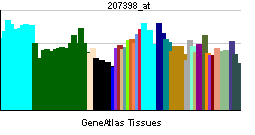HOXD13
| Homeobox D13 | |||||||||||
|---|---|---|---|---|---|---|---|---|---|---|---|
| Identifiers | |||||||||||
| Symbols | HOXD13 ; BDE; BDSD; HOX4I; SPD | ||||||||||
| External IDs | Template:OMIM5 Template:MGI HomoloGene: 20147 | ||||||||||
| |||||||||||
| RNA expression pattern | |||||||||||
 | |||||||||||
 | |||||||||||
| More reference expression data | |||||||||||
| Orthologs | |||||||||||
| Template:GNF Ortholog box | |||||||||||
| Species | Human | Mouse | |||||||||
| Entrez | n/a | n/a | |||||||||
| Ensembl | n/a | n/a | |||||||||
| UniProt | n/a | n/a | |||||||||
| RefSeq (mRNA) | n/a | n/a | |||||||||
| RefSeq (protein) | n/a | n/a | |||||||||
| Location (UCSC) | n/a | n/a | |||||||||
| PubMed search | n/a | n/a | |||||||||
Homeobox D13, also known as HOXD13, is a human gene.[1]
This gene belongs to the homeobox family of genes. The homeobox genes encode a highly conserved family of transcription factors that play an important role in morphogenesis in all multicellular organisms. Mammals possess four similar homeobox gene clusters, HOXA, HOXB, HOXC and HOXD, located on different chromosomes, consisting of 9 to 11 genes arranged in tandem. This gene is one of several homeobox HOXD genes located in a cluster on chromosome 2. Deletions that remove the entire HOXD gene cluster or the 5' end of this cluster have been associated with severe limb and genital abnormalities. Mutations in this particular gene cause synpolydactyly.[1] The product of the mouse Hoxd13 gene plays a role in axial skeleton development and forelimb morphogenesis.[2]
See also
References
- ↑ 1.0 1.1 "Entrez Gene: HOXD13 homeobox D13".
- ↑ Davis AP, Capecchi MR.A mutational analysis of the 5' HoxD genes: dissection of genetic interactions during limb development in the mouse. Development. 1996 Apr;122(4):1175-85. PMID:8620844
Further reading
- Johnson RL, Tabin CJ (1997). "Molecular models for vertebrate limb development". Cell. 90 (6): 979–90. PMID 9323126.
- Goodman FR (2003). "Limb malformations and the human HOX genes". Am. J. Med. Genet. 112 (3): 256–65. doi:10.1002/ajmg.10776. PMID 12357469.
- Scott MP (1992). "Vertebrate homeobox gene nomenclature". Cell. 71 (4): 551–3. PMID 1358459.
- D'Esposito M, Morelli F, Acampora D; et al. (1991). "EVX2, a human homeobox gene homologous to the even-skipped segmentation gene, is localized at the 5' end of HOX4 locus on chromosome 2". Genomics. 10 (1): 43–50. PMID 1675198.
- McAlpine PJ, Shows TB (1990). "Nomenclature for human homeobox genes". Genomics. 7 (3): 460. PMID 1973146.
- Acampora D, D'Esposito M, Faiella A; et al. (1990). "The human HOX gene family". Nucleic Acids Res. 17 (24): 10385–402. PMID 2574852.
- Sarfarazi M, Akarsu AN, Sayli BS (1995). "Localization of the syndactyly type II (synpolydactyly) locus to 2q31 region and identification of tight linkage to HOXD8 intragenic marker". Hum. Mol. Genet. 4 (8): 1453–8. PMID 7581388.
- Muragaki Y, Mundlos S, Upton J, Olsen BR (1996). "Altered growth and branching patterns in synpolydactyly caused by mutations in HOXD13". Science. 272 (5261): 548–51. PMID 8614804.
- Akarsu AN, Stoilov I, Yilmaz E; et al. (1997). "Genomic structure of HOXD13 gene: a nine polyalanine duplication causes synpolydactyly in two unrelated families". Hum. Mol. Genet. 5 (7): 945–52. PMID 8817328.
- Warren ST (1997). "Polyalanine expansion in synpolydactyly might result from unequal crossing-over of HOXD13". Science. 275 (5298): 408–9. PMID 9005557.
- Goodman FR, Mundlos S, Muragaki Y; et al. (1997). "Synpolydactyly phenotypes correlate with size of expansions in HOXD13 polyalanine tract". Proc. Natl. Acad. Sci. U.S.A. 94 (14): 7458–63. PMID 9207113.
- Goodman F, Giovannucci-Uzielli ML, Hall C; et al. (1998). "Deletions in HOXD13 segregate with an identical, novel foot malformation in two unrelated families". Am. J. Hum. Genet. 63 (4): 992–1000. PMID 9758628.
- Limongi MZ, Pelliccia F, Gaddini L, Rocchi A (2000). "Clustering of two fragile sites and seven homeobox genes in human chromosome region 2q31-->q32.1". Cytogenet. Cell Genet. 90 (1–2): 151–3. PMID 11060466.
- Harrington JJ, Sherf B, Rundlett S; et al. (2001). "Creation of genome-wide protein expression libraries using random activation of gene expression". Nat. Biotechnol. 19 (5): 440–5. doi:10.1038/88107. PMID 11329013.
- Goodman FR, Majewski F, Collins AL, Scambler PJ (2002). "A 117-kb microdeletion removing HOXD9-HOXD13 and EVX2 causes synpolydactyly". Am. J. Hum. Genet. 70 (2): 547–55. PMID 11778160.
- Kosaki K, Kosaki R, Suzuki T; et al. (2002). "Complete mutation analysis panel of the 39 human HOX genes". Teratology. 65 (2): 50–62. doi:10.1002/tera.10009. PMID 11857506.
- Debeer P, Bacchelli C, Scambler PJ; et al. (2002). "Severe digital abnormalities in a patient heterozygous for both a novel missense mutation in HOXD13 and a polyalanine tract expansion in HOXA13". J. Med. Genet. 39 (11): 852–6. PMID 12414828.
- Caronia G, Goodman FR, McKeown CM; et al. (2003). "An I47L substitution in the HOXD13 homeodomain causes a novel human limb malformation by producing a selective loss of function". Development. 130 (8): 1701–12. PMID 12620993.
External links
- HOXD13+protein,+human at the US National Library of Medicine Medical Subject Headings (MeSH)
This article incorporates text from the United States National Library of Medicine, which is in the public domain.
| This protein-related article is a stub. You can help Wikipedia by expanding it. |